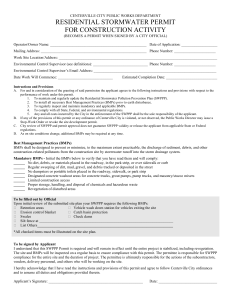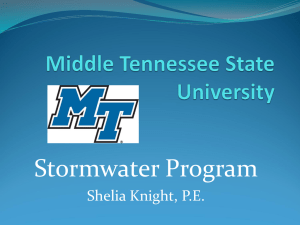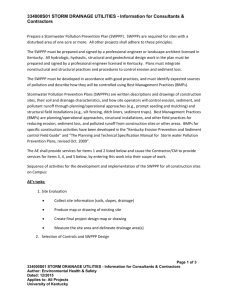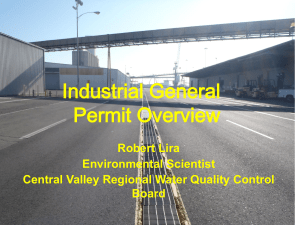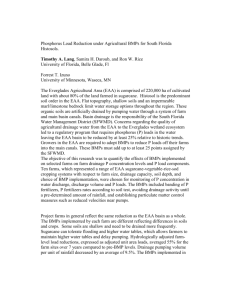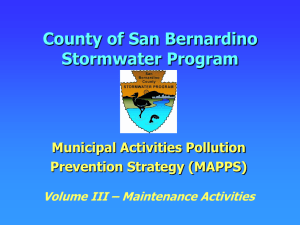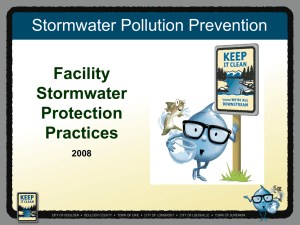CENTERVILLE CITY PUBLIC WORKS DEPARTMENT
advertisement
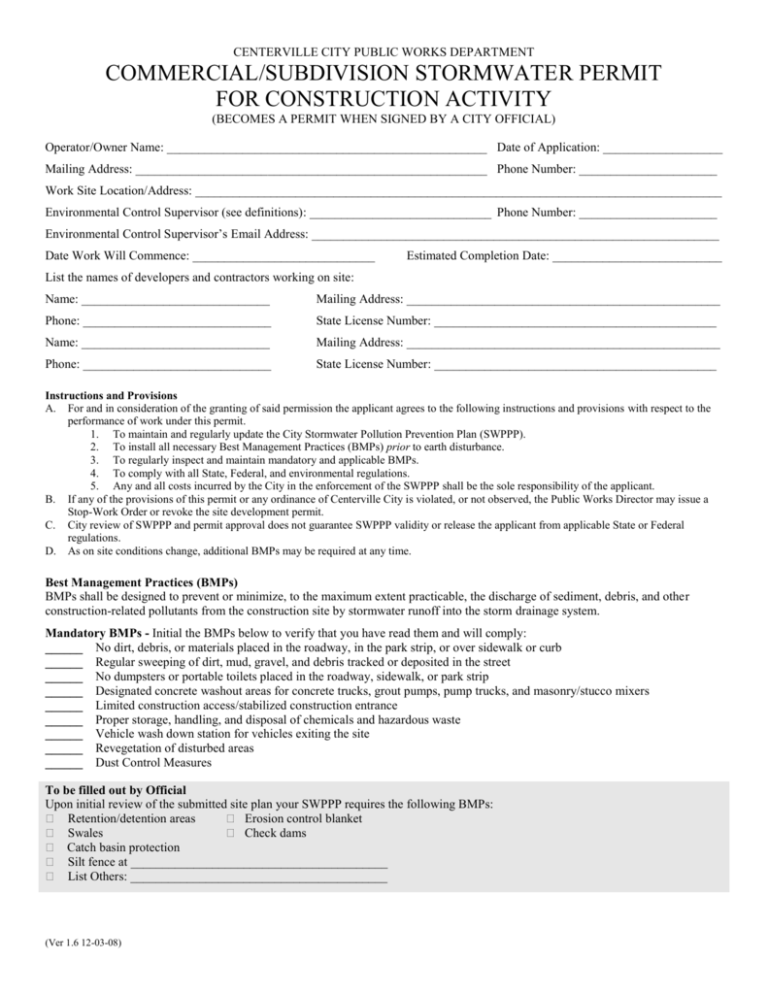
CENTERVILLE CITY PUBLIC WORKS DEPARTMENT COMMERCIAL/SUBDIVISION STORMWATER PERMIT FOR CONSTRUCTION ACTIVITY (BECOMES A PERMIT WHEN SIGNED BY A CITY OFFICIAL) Operator/Owner Name: ___________________________________________________ Date of Application: ___________________ Mailing Address: ________________________________________________________ Phone Number: ______________________ Work Site Location/Address: ____________________________________________________________________________________ Environmental Control Supervisor (see definitions): _____________________________ Phone Number: ______________________ Environmental Control Supervisor’s Email Address: _________________________________________________________________ Date Work Will Commence: _____________________________ Estimated Completion Date: ___________________________ List the names of developers and contractors working on site: Name: ______________________________ Mailing Address: __________________________________________________ Phone: ______________________________ State License Number: _____________________________________________ Name: ______________________________ Mailing Address: __________________________________________________ Phone: ______________________________ State License Number: _____________________________________________ Instructions and Provisions A. For and in consideration of the granting of said permission the applicant agrees to the following instructions and provisions with respect to the performance of work under this permit. 1. To maintain and regularly update the City Stormwater Pollution Prevention Plan (SWPPP). 2. To install all necessary Best Management Practices (BMPs) prior to earth disturbance. 3. To regularly inspect and maintain mandatory and applicable BMPs. 4. To comply with all State, Federal, and environmental regulations. 5. Any and all costs incurred by the City in the enforcement of the SWPPP shall be the sole responsibility of the applicant. B. If any of the provisions of this permit or any ordinance of Centerville City is violated, or not observed, the Public Works Director may issue a Stop-Work Order or revoke the site development permit. C. City review of SWPPP and permit approval does not guarantee SWPPP validity or release the applicant from applicable State or Federal regulations. D. As on site conditions change, additional BMPs may be required at any time. Best Management Practices (BMPs) BMPs shall be designed to prevent or minimize, to the maximum extent practicable, the discharge of sediment, debris, and other construction-related pollutants from the construction site by stormwater runoff into the storm drainage system. Mandatory BMPs - Initial the BMPs below to verify that you have read them and will comply: ______ No dirt, debris, or materials placed in the roadway, in the park strip, or over sidewalk or curb ______ Regular sweeping of dirt, mud, gravel, and debris tracked or deposited in the street ______ No dumpsters or portable toilets placed in the roadway, sidewalk, or park strip ______ Designated concrete washout areas for concrete trucks, grout pumps, pump trucks, and masonry/stucco mixers ______ Limited construction access/stabilized construction entrance ______ Proper storage, handling, and disposal of chemicals and hazardous waste ______ Vehicle wash down station for vehicles exiting the site ______ Revegetation of disturbed areas ______ Dust Control Measures To be filled out by Official Upon initial review of the submitted site plan your SWPPP requires the following BMPs: Retention/detention areas Erosion control blanket Swales Check dams Catch basin protection Silt fence at _________________________________________ List Others: _________________________________________ (Ver 1.6 12-03-08) COMMERCIAL/SUBDIVISION SWPPP COMPONENTS: Attach to this application one copy of a site map to include the following items: 1. 2. 3. 4. 5. 6. 7. 8. Project name and address Direction of slope Location of concrete washout area Location of stabilized construction entrance Location of vehicle wash down station Location of dumpster Location of portable toilet Location of existing and proposed storm drainage systems (i.e. creeks, retention basins, wetlands and irrigation ditches, etc.) 9. Location of catch basin protection 10. Location of silt fence/perimeter BMP 11. Copy of Best Management Practice specification sheets To be signed by Applicant I understand that this SWPPP Permit is required and will remain in effect until the entire project is stabilized, including revegetation. The site and BMPs will be inspected on a regular basis to ensure compliance with this permit. The permittee is responsible for SWPPP compliance for the entire site and the duration of project. The permittee is ultimately responsible for the actions of the subcontractors, vendors, delivery personnel, and others who will be working on the site. I hereby acknowledge that I have read the instructions and provisions of this permit and agree to follow Centerville City ordinances and to assume all duties and obligations provided therein. Applicant’s Signature: __________________________________________________ Date: _______________________________ Official Use Only ______ Initial if applicant has a SWPPP or site plan. _______ Initial if SWPPP or site plan has been reviewed. ______ Initial if applicant has a valid UPDES Permit. _______ Initial if Optional Secondary Control Measures are Required List State Permit Number and expiration date: _____________________________________________ City Permit Approved by: ______________________________________ Date: ____________________________ Permit Number: _____________________________________ Comments: (Ver 1.6 12-03-08) COMMON DEFINITIONS: The Environmental Control Supervisor should be the person (typically the site superintendent) who has the authority to correct violations of the stormwater permit. This person shall receive a stormwater inspection, hand-delivered, by email, or standard mail and shall have ten (10) days to correct the violation or work out a remediation schedule before further enforcement action is required. Stormwater originates from precipitation and snowmelt. Stormwater enters the storm drainage system after flowing over the earth’s surface. Stormwater flowing over a construction site picks up various pollutants and transports these pollutants into the storm drainage system. The storm drainage system consists of streets, creeks, drainage ditches, catch basins, storm drains, sub drains, swales, wetlands, and culverts. The water in the storm drainage system is not filtered or treated. Stormwater Pollutants include but are not limited to: disturbed soils contaminated with oils, grease, paint, and mortar mix; trash and debris (such as plastic, Styrofoam, etc); concrete washout; and portable toilet wastes. Polluted stormwater negatively impacts groundwater drinking supplies, creeks, and wetlands. A clogged storm drain can cause flooding. A Stormwater Pollution Prevention Plan (SWPPP) is a plan used to reduce the amount of stormwater pollution generated from construction activities. For this permit, a SWPPP includes a site map and a set of Best Management Practices. Best Management Practices (BMPs) are practices and structural objects used to reduce stormwater pollution generated from construction activities. Street sweeping is a typical practice that prevents contaminated soils from entering the storm drainage system. Silt fence installation is a structural object that traps sediment but allows clean water to runoff the site. Drainage Patterns and/or downward direction of slope tells us where the stormwater will flow and which area of the lot needs BMPs to filter or collect polluted stormwater. Steep slopes may require additional BMPs. Existing and proposed storm drainage systems: The location of the storm drainage system is required in order to decide which BMPs are necessary. For example: a creek located on the down slope side of a lot will need protection to prevent polluted stormwater from entering the creek. A creek located on the up slope side of a lot may require fewer BMPs. Location of BMPs (silt fence, retention area, catch basin protection, portable toilets, dumpsters). Effective BMPs need to be located correctly and regularly inspected. Identifying the location of BMPs helps to increase awareness. A silt fence or retention area located on the up slope side of a lot is not effective for filtering or capturing polluted stormwater. An improperly installed silt fence will not capture sediment. UNDERSTANDING MANDATORY BMPS: No dirt, debris, or materials placed in the roadway, in the park strip, or over sidewalk or curb: Dirt, debris, and materials placed in the street can potentially end up in the storm drainage system. Dirt may contain pollutants and debris and materials may clog the storm drainage system and cause flooding. Regular sweeping of dirt, mud, gravel, and debris tracked or deposited in the street helps prevent contaminated soils from entering the storm drainage system and polluting waters. No dumpsters or portable toilets placed in the roadway, sidewalk, or park strip: Portable toilets located in or near the street may tip over and allow wastes to enter the storm drainage system. Portable toilets should be staked into the ground to prevent tipping. Dumpsters located in the street may leak liquid wastes into the storm drainage system. Small trash from overflowing dumpsters may clog storm drains and cause flooding. Designated concrete washout areas for concrete trucks, grout pumps, pump trucks, and masonry/stucco mixers: A designated washout allows trucks to dispose of wastes into a contained area. Washout randomly discharged on a lot may be unintentionally tracked into the street or contaminate creeks, groundwater supplies, and the storm drainage system. Do not install concrete washout areas next to or in close proximity of catch basins, creeks, retention areas, or drainage ditches. (Ver 1.6 12-03-08) Limited Construction Access/Stabilized Construction Entrance: A limited construction access allows greater control of pollutants leaving the site and reduces the amount of area where sweeping and cleanup is required. A stabilized construction entrance reduces the tracking of sediment onto streets or public right-of-ways. Proper storage, handling, and disposal of chemicals and hazardous waste: Reduces the chance of spills and contamination. Chemicals should not be stored near or discarded into any part of the storm drainage system. Do not store or use chemicals next to or in close proximity of catch basins, streets, creeks, retention areas, or drainage ditches. Vehicle wash down station for vehicles exiting the site: A vehicle wash down station is used to spray off the tires of vehicles exiting a site. Tires pick up pollutants in their treads and track them into the street. Common construction site pollutants tracked into the street include dirt, concrete washout, grease, oil, and wet mortar mixes. Revegetation of disturbed areas: Revegetation reduces the amount of exposed soils vulnerable to soil erosion and runoff. Dust Control Measures: Construction activities, such as clearing and excavation, create soil disturbance and open space allowing wind to pick up dust particles. Dust transported by wind contributes to both air and stormwater pollution. Dust control measures include, but are not limited to: mulch, sprinkling, vegetative cover, wind breaks, stone, and spray on chemical soil treatments. UNDERSTANDING ADDITIONAL BMPS: Retention areas are designed to collect and hold surface and stormwater runoff from a site until it evaporates or infiltrates into the ground. Retention areas prevent pollutants from leaving the site and entering the storm drainage system. Retention areas should be inspected regularly for trash and sediment build-up. An erosion control blanket is needed on steep slopes in order to reduce erosion and promote vegetation growth. Properly installing an erosion control blanket saves time and reduces long-term maintenance. Erosion control blankets need to be inspected regularly for tears, loose staples (where used), and the existence of rills and gullies. Rills and gullies need to be filled in and raked. Swales help prevent water from leaving a site and can be used to direct water flow to a designated area such as a retention pond. Silt fence is used to filter stormwater runoff. Silt fence needs to be properly entrenched, overlapping (where two sections meet), and stakes must be positioned on the down slope side of the fence. Properly installing silt fence saves time and reduces long-term maintenance. Silt fence should be inspected regularly for tears and holes. Knocked down silt fence needs to be repaired and maintained. Sediment build-up at the base needs to be periodically removed. Check dams are used at outfalls, in ditches, or in the street to slow down the velocity of stormwater. High velocity flows contribute to soil erosion. Check dams include but are not limited to gravel bags, large boulders, and silt fence (in low flow areas). Check dams should be inspected regularly for effectiveness and proper location. Catch basin protection (required if down slope from site) includes but is not limited to gravel bags, filter sacks, and filter socks. Catch basin protection is a secondary BMP that helps prevent sediment and other pollutants from entering the storm drainage system. Catch basin protection should be inspected regularly. The sediment build-up and trash collected around the catch basin should be periodically removed and properly disposed of. Catch basin protection should be free of holes and tears. (Ver 1.6 12-03-08)
